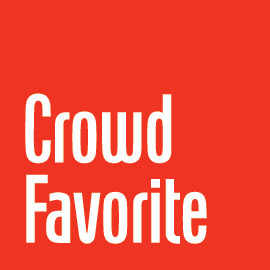*This article was originally published on Forty.co. Forty is now Crowd Favorite.
During a recent sleepless night, I dragged myself out to the couch to watch TV.
I was hoping to catch up on some brainless Bravo reality shows or gawk at the ridiculous hoarders on TLC, but all I could find was infomercials. I succumbed, in hopes it would bore me back to sleep, but like most marketers, I couldn’t watch the ads without analyzing them.
As I watched more and more of this mindless mush, I started to realize just how cheesy and stereotypical they are. But they work. Companies wouldn’t keep making them if they didn’t—just look at how home shopping has skyrocketed QVC into a multibillion-dollar business. In an age of hot trends and shot-gun marketing tactics, there are a few things we can learn about advertising from this old-school practice:
1. Figure out why you’re the best, and say it.
One of the keys to building a successful business is knowing the one point (at least) that makes you different and better than your competitors. Get away from the defaults, and look for the qualities where you can say you’re “the best” or “the only one.” It should be something that’s ownable, believable, and important to your customers. Then, don’t be afraid to shout it out from the rooftops.
Infomercial example: “Snuggie is the only blanket with sleeves!” – Snuggie
2. Back up your claims with testimonials, facts, and figures.
You can tout your benefits until the cows come home, but firsthand reviews and supporting proof goes a long way. People love sharing their opinions, and potential buyers find reassurance in hearing positive feedback from others like them. Facts and figures also help support your claims and prove the effectiveness of your product or service.
Infomercial example: “I lost 50 pounds, and I feel beautiful!” – Xenadrin
3. Talk about solutions and benefits, not features.
No one cares that your frying pan has super duper heating technology or that your consulting agency has 106 combined years of experience. Your customers want to know how you’re going to help solve their problems. When you rely on features, you’re not speaking your customers’ language, and they move on. Features can be duplicated. Your unique benefits and solutions can’t.
Infomercial example: “Feed your hungry family in under three minutes.” – Ron Popeil Pasta Maker
4. Add value by showing multiple uses.
The only thing better than having a really useful product or service is having one that’s useful in *lots* of ways. Your company probably promotes the traditional benefits that most customers can see at face value, but you can add even more value by showing them the additional creative ways they’ll benefit from working with you.
Infomercial example: “Style Snaps aren’t just for hems. Tame unruly lapels, belts, and pockets without a stitch!” – Style Snaps
5. Don’t just say it. Show it!
Infomercials are great at showing all the ways a product works. Describing what your product or service does is always helpful, but people are visual. We love examples and seeing things in action. Say why your company is awesome, and then show why it’s awesome. Bonus points for comparing how you’re better than competitors (in a respectful way, of course)!
Infomercial example: Showing two vacuums pick up dirt side by side, like Oreck Vacuums.
6. Tell stories.
Storytelling is more engaging than selling, and it helps people remember you. People want to feel like they’re having a conversation with a friend, not defending themselves against a pushy sales pitch. Talk to some of your real customers, and find out exactly how your business helped them. Then, tap into your potential buyers’ emotions by telling the story and showing how they could benefit too.
Infomercial example: “When I first started P90X, I was 374 pounds… A close friend confronted me and asked me if I was afraid another man would have to raise my kids… To date, I’ve lost 180 pounds with P90X. Now that I’ve lost all this weight, I can’t sit still!” – P90X
7. Use memorable phrases and taglines.
Sum up your brand experience in a short, clever phrase or tagline. This will provide something for people to latch on to and help them remember you.
Infomercial example: “Set it, and forget it!” – Ronco Rotisserie
8. Use scarcity or promotions to get people in the door.
As humans, we suffer from loss aversion, which means we’re much more sensitive to losses than to gains. Part of the reason infomercials are so successful is they use emotional hot buttons, like scarcity and hard-to-resist deals. They create a subconscious drive to take action immediately, even if you wouldn’t necessarily want the product under normal circumstances. Don’t lie to your customers or make deceiving offers, but rather, offer them a small incentive for taking the leap and trying out your company.
Infomercial example: “Call in the next 20 minutes, and get six pounds of Oxyclean!” – Oxyclean
9. Offer guarantees and assurances.
People love feeling confident and reassured. Guarantees can be a powerful way to prove your confidence in your business and convince them to act. Hearing phrases like, “Guaranteed or your money back” and “If you’re not fully satisfied, we want to hear about it” reduces the risk for your customers and makes them feel more comfortable trusting you. Just make sure you can deliver on your promises!
Informercial example: “LockFresh comes with a 30-day money back guarantee!” – LockFresh
10. Give your customers quick buy options.
All of your customers have different decision modes. Some make decisions quickly, while others need time to scour through the details and ruminate before making choices. For those competitive and spontaneous decision styles, give them obvious calls to action and easy ways to take the next step.
Infomercial example: “Order now at 1-800-780-6744!” – Tony Little’s Gazelle Trainer
Although infomercials are primarily used for B2C products, the same principles can be applied successfully to most services and B2B companies. There are definitely downfalls to infomercials, but if you look past the host’s forced smile, the fake audience, and totally random products (Hair in a Can, anyone?), you just may find some helpful tips that could transform your business.
Written by
Shaina Rozen
Former Communication Director
The same team and processes that made Forty synonymous with high-quality UX design and content strategy have been extended through integration with Crowd Favorite.
If you have a digital project in mind, now’s a great time to reach out!





